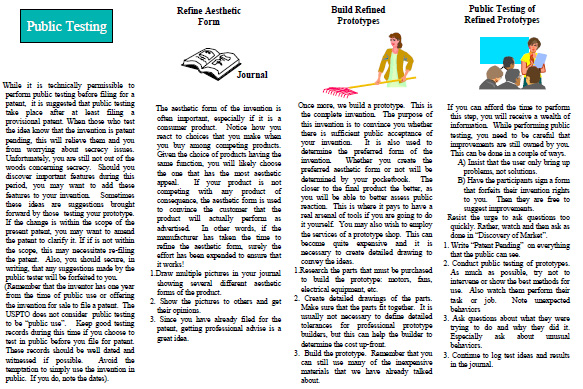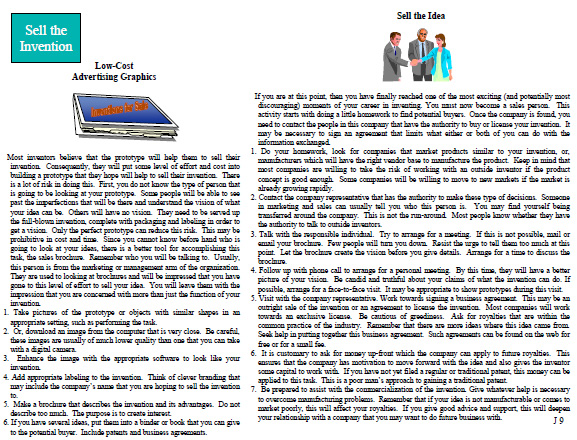Hierarchical TRIZ Algorithms--Step J. Implement the Solution
Editor | On 18, Apr 2006
Hierarchical TRIZ Algorithms is a how-to TRIZ book. It is designed to assist both beginning and advanced users. Each month, the TRIZ-Journal will publish another chapter of the book. This month’s installment includes the 10th step of the 10 step algorithm (shown on the cover) :
J. Implement the Solution
In all, there were 12 installments. Should you decide to purchase the most current edition of the complete book contact the publisher at:
http://www.3mpub.com/TRIZ/

No idea, no matter how good it is, will implement itself. Each concept is still quite vulnerable and must be handled with diligence and discipline in order to make it into a viable product.
Refining the Concept
If the TRIZ methodology has been followed, it is likely that several concepts will have been generated. Each of these ideas can be further refined by making a succession of drawings in your invention journal. Drawing successive drawings in which small improvements are made to conserve space, weight and cost will help to refine the idea to the point that you can build a more complete prototype. During this refinement, we can consider different configurations and orientations of elements. We can also consider the partial or complete consolidation of similar and dissimilar elements. Folding elements into themselves and other elements can further refine the product to decrease its size.
Prototypes
Since we have already created other prototypes, let us review the purpose of each round. The purpose of the first round of prototypes was to help understand the relative importance of each knob. This was done in the cause-effect stage. The second round of prototypes was to verify that the solutions found by resolving the contradictions were viable and that there were no major risks left. This was done in the resolve contradictions stage to determine whether there were more improvements required.
Do not make the mistake of building any of these prototype at great expense. It is almost an immutable law that the first prototypes will have serious flaws. Making expensive prototypes can exhaust your resources. Discouragement often sets in and the final product may never materialize. For this reason, the these prototypes should be as inexpensive as possible. Remember that the purpose of these first prototypes is to convince you that all of the ideas work together.
This next round of prototypes is to convince you that you haven’t left anything out so that your invention is ready for patent filing. It will also be used to persuade prospective customers that your idea is marketable. Because these prototypes are more extensive, they may also be a little more expensive.
In order to build prototypes, you will need materials and tools. It is not necessary to have all tools and pieces on hand when you begin, but you will find this to be a big time saver. One helpful hint is to create a stockpile of parts, which can be readily modified to build prototypes. Keep bins of raw materials such as small, medium and large plastic, metal and wood parts. These storage bins need not take over the workshop and they can be stocked by taking apart unused or inoperative equipment from the home or second-hand stores. Make it a practice to disassemble second hand goods to create useful parts. You will learn a lot about different manufacturing methods and collect expensive parts at the same time.
Combining Concepts
Once we have refined the individual concepts, it is possible to create a “super product†by the combination of these individual concepts.
Before doing this, some people find it useful to rank the ideas against business and customer needs. This gives an idea of the relative strength of each concept. This method is often referred to as PUGH Concept selection. The front end of Quality Function Deployment (QFD) also accomplishes the same purpose.
If adequate resources are available, a DOE can be performed. DOE stands for Design of Experiment and is a favorite Six-Sigma tool for determining the relative strength of various knobs. In this context we are interested in the relative strength of each concept and how much of each idea should be combined into one final product. This can be practically done by a two level DOE where the concepts are combined in different combinations.
This allows us to determine the combination of solutions that gives the most value to the customer or the business. The beauty of a DOE is that a partial list of combinations can be tried rather than the full compliment. The final output of the DOE is an equation that can be optimized to give the best “super productâ€. It is not the purpose of this text to go into detail on how to set-up or perform a DOE Assuming that the previous steps have been followed (including the patent search from Identifying Physical Phenomena) you are now ready to file a patent.
Two types of patents are considered: a provisional or “poor man’s†patent and a non-provisional or regular patent. Congress created the provisional patent in the late 90’s to help spur small business growth. A provisional patent is basically a place holder for a filing date, since the patent examiner will not even look at it until the regular patent is filed. (It can also serve as a substitute for building working prototypes, also called “reduction to practiceâ€).
The provisional patent must include sufficient detail that someone “skilled in the art†could build your invention.
While it is good practice to give as much detail as possible, do not worry about flowery legal wording and drawings. Attach legible drawings and the cover-sheet provided through the USPTO web-site and pay a fee of about $80.
Provisional patents are in effect until one year from the date of filing. They need to be converted to a regular patent within the year or your invention is considered to be abandoned. One strategy is to first, file a provisional patent and then license the idea. Part of the business agreement is up-front money which can be used to file the non-provisional patent via a patent attorney or agent.
Traditional patents are much more expensive. If you are in business for yourself, it is usually difficult to justify the expense of a non-provisional patent, before the market has proven itself. On the other hand, most large companies have greater resources and therefore rarely bother with the added time and effort of a provisional patent.
When you have established a filing date, you are now patent pending. Write patent pending on your prototypes. You are now free to sell, license or manufacture your invention. Understand that you are still at some risk that someone else has already patented the idea. Your degree of risk is directly related to the depth of your patent searching and to how close your invention is to other related patents.
Selling or Licensing Your Idea
Selling or licensing your idea can be an exhilarating and discouraging experience. Now, you will be dealing with people who have a monetary interest in their own business prospects. They may not be as encouraging as others have been. Potential customers can be manufacturers, distributors or the final user. One way to license your idea is to directly contact a manufacturing organization that makes related products or that has the same vendor base to produce the product. Many manufacturing companies will be open to licensing your invention.
Most of the time, you will be trying to sell or license your invention from afar. This is difficult since the most effective persuasion usually comes from personal contact. Consequently, the initial stages of selling your idea need to be focused on getting you and your invention in the physical presence of the person that has the authority to make the decision. Most of the information that is passed should have the intent of wetting the appetite. The prospective buyer will have the alternate desire to weed out the good ideas and will be trying to get as much information as possible before a personal sales contact. One way around this dilemma is to create a sales brochure that tells just enough to get the vision across, but leaves much to the imagination. Another reason to have a sales brochure is that prototypes are often poor tools for creating a vision.
If the prospective buyer is interested, arrange a personal visit to discuss the invention and possible business arrangements. In order to talk freely with the company representatives, it is usually necessary to enter into an agreement which will limit what either or both parties may do with the information that they will receive. Ask the company representative what they would prefer and then consider the risks to yourself and your future prospects before signing.
If the company is willing to license the product, it is expected that a business agreement will be entered into. Such agreements can be found through legal consultation or on the web. Modify these to suit your needs. It is customary to ask for money up front. This money can be applied to the royalties. This is good for two reasons. First, this gives motivation to the manufacturer to make something of the product.
Secondly, this gives some money to handle the costs of filing a non-provisional or traditional patent, which can cost several thousand dollars.
Commercializing
You may decide that you would rather manufacture your invention yourself. (Admittedly, there is often more money to be made in this way. However, it is assumed that most people who would use the full TRIZ approach described in this book will more likely find themselves licensing their inventions rather than manufacturing them). At any rate, whether you decide to manufacture the product or license it, there will usually be a need to “maintain†the invention. Remember, you know the most about the invention. It is good business practice to support the invention with free advice and problem solving. You will find that this will open the way for future work if you do not simply leave your invention on their doorstep. The company will know that you are a good source of ideas because you continue to provide support.
A few final ideas about inventing for profit. Do not get to wrapped up in one idea. You can afford to throw away a few good ideas. You now have an infinite source of ideas. Do not throw away good friendships over inventing. Again, you can afford to throw away or give away a few good ideas. If your business model is not working, try new approaches. Find a mentor that can help you with the business side of things. The important thing is to hone a business model that allows you to invent and create cash flow that will empower you with more time and resources to invent.








